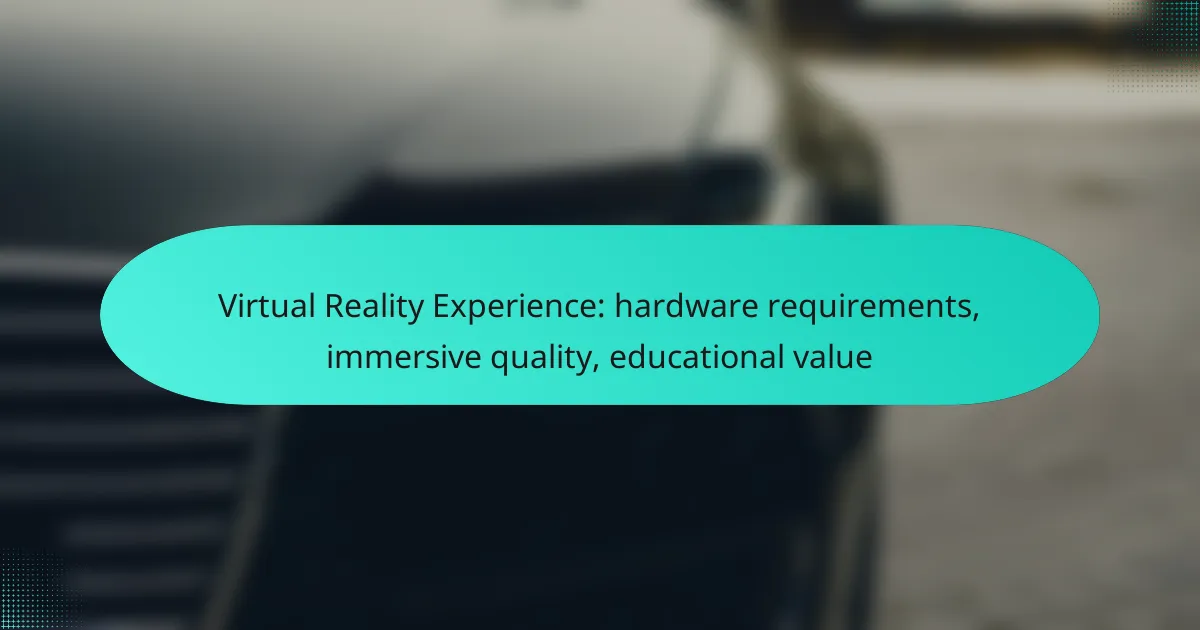Virtual reality (VR) technology has transformed the way we engage with digital content, requiring specific hardware such as a compatible headset and a powerful computer to ensure an immersive experience. The quality of immersion is influenced by various factors, including visual fidelity and audio realism, which enhance user engagement. Additionally, VR holds substantial educational value, providing interactive learning environments that promote deeper understanding and retention of complex concepts.
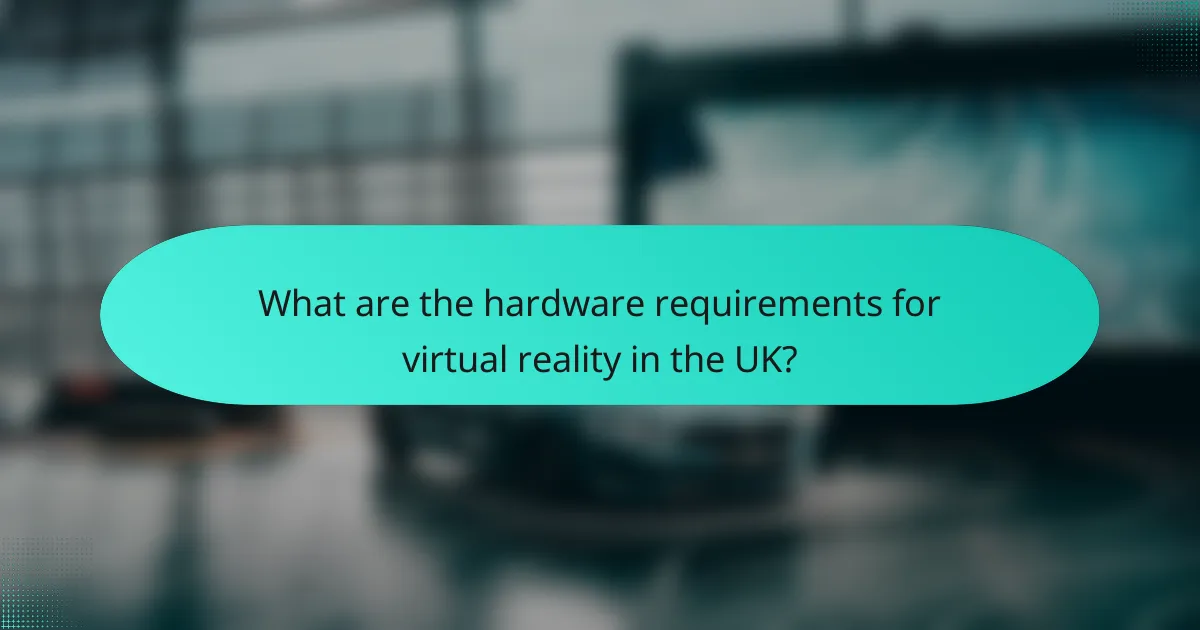
What are the hardware requirements for virtual reality in the UK?
The hardware requirements for virtual reality (VR) in the UK typically include a compatible headset, a powerful computer, and additional peripherals. Meeting these specifications ensures a smooth and immersive VR experience.
Minimum specifications for VR headsets
Minimum specifications for VR headsets generally include a resolution of at least 1080p, a refresh rate of 90 Hz, and a field of view around 100 degrees. These basic requirements allow for a functional VR experience but may not deliver the highest quality visuals or responsiveness.
Examples of entry-level headsets that meet these minimum specifications include the Oculus Quest 2 and the PlayStation VR. While these devices are accessible, users may notice limitations in graphics and tracking compared to higher-end models.
Recommended PC specifications for VR
For an optimal VR experience, recommended PC specifications typically include at least a quad-core processor, 16 GB of RAM, and a dedicated graphics card such as the NVIDIA GeForce RTX 3060 or AMD Radeon RX 6700 XT. These components ensure that the VR software runs smoothly and responsively.
Additionally, a USB 3.0 port and an HDMI 2.0 output are often required for connecting the headset. Investing in a powerful PC not only enhances performance but also future-proofs the system for upcoming VR titles.
Compatibility with popular VR systems
Compatibility with popular VR systems varies based on the headset and the PC specifications. Major systems like Oculus Rift, HTC Vive, and Valve Index have specific requirements that must be met for optimal performance. Users should check the compatibility of their hardware with the desired VR system before making a purchase.
Many VR headsets come with software that can help determine if a PC meets the necessary specifications. This can prevent compatibility issues and ensure a better overall experience when using VR applications.
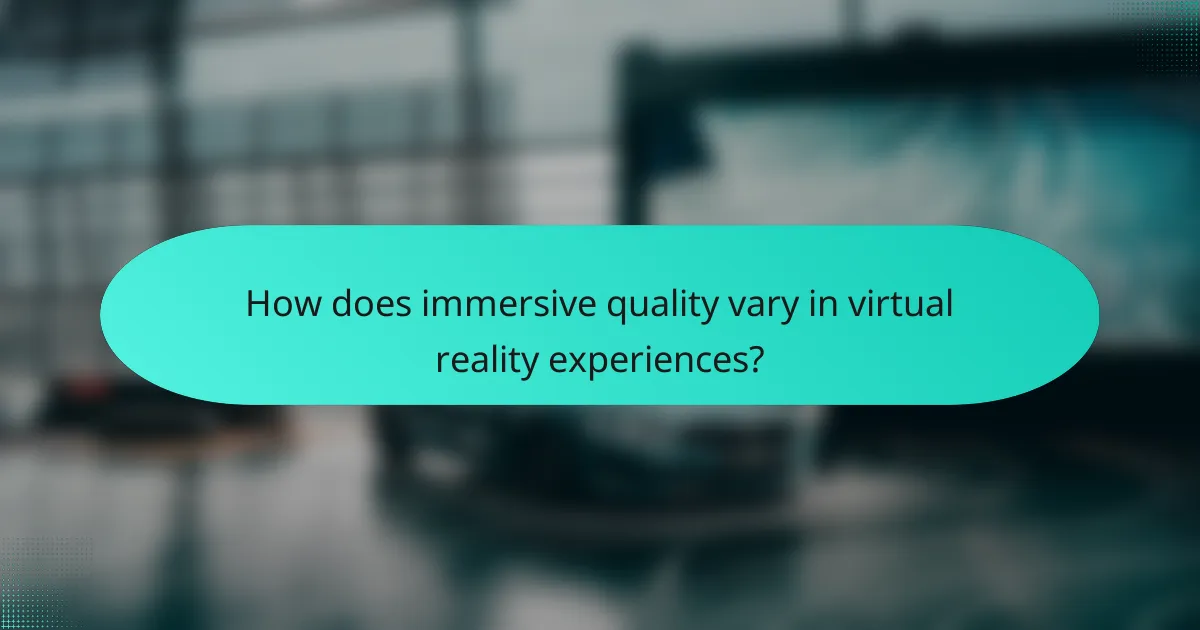
How does immersive quality vary in virtual reality experiences?
Immersive quality in virtual reality (VR) experiences can differ significantly based on hardware, software, and user interaction. Factors such as visual fidelity, audio realism, and user engagement all contribute to how immersive a VR experience feels.
Factors affecting immersion in VR
Several key factors influence immersion in virtual reality. Visual clarity, sound quality, and the ability to interact with the environment all play crucial roles. High-resolution displays and spatial audio enhance the sense of presence, making users feel as though they are truly part of the virtual world.
User comfort and the design of the VR environment also impact immersion. A well-designed interface that minimizes motion sickness and allows for natural movements can significantly enhance the overall experience.
Comparison of VR headset display technologies
VR headsets utilize various display technologies, each affecting immersion differently. LCD and OLED are the most common types, with OLED generally providing better contrast and color accuracy. The choice between these technologies can influence how realistic the virtual environment appears.
Additionally, the resolution of the headset is crucial. Higher resolutions reduce the “screen door effect,” where users see the lines between pixels, thus enhancing immersion. Current high-end headsets often feature resolutions above 2000 x 2000 pixels per eye.
Impact of frame rates on user experience
Frame rates are vital for a smooth VR experience, with higher rates leading to better immersion. A frame rate of at least 90 frames per second (FPS) is recommended to minimize motion sickness and provide a fluid experience. Lower frame rates can result in choppy visuals, detracting from the sense of presence.
Moreover, maintaining consistent frame rates is essential. Fluctuations can cause discomfort and disrupt the user’s engagement with the virtual environment. Users should ensure their hardware can support stable frame rates for optimal experiences.

What is the educational value of virtual reality?
Virtual reality (VR) offers significant educational value by creating immersive learning environments that enhance engagement and retention. It allows students to experience complex concepts and scenarios in a hands-on manner, fostering deeper understanding and practical skills.
Applications of VR in UK education
In the UK, VR is increasingly integrated into various educational settings, from primary schools to universities. Subjects such as history, science, and geography benefit from VR applications that transport students to historical events, simulate scientific experiments, or explore geographical locations in 3D. This technology supports diverse learning styles and can be tailored to meet specific curriculum requirements.
Moreover, institutions are using VR for vocational training, enabling students to practice skills in a safe, controlled environment. For example, medical students can perform virtual surgeries, gaining experience without the risks associated with real-life procedures.
Case studies of VR in classrooms
Several UK schools have successfully implemented VR into their curricula. For instance, a secondary school in London utilized VR headsets to teach students about the solar system, allowing them to explore planets and celestial bodies interactively. Feedback indicated that students were more engaged and retained information better than through traditional teaching methods.
Another case study involved a college that used VR simulations for engineering students, enabling them to visualize complex structures and mechanics. This hands-on approach led to improved problem-solving skills and a greater understanding of theoretical concepts.
Benefits of VR for remote learning
VR provides unique advantages for remote learning by creating immersive experiences that can replicate in-person interactions. Students can participate in virtual classrooms, collaborate on projects, and engage with instructors in a 3D space, which helps mitigate feelings of isolation often associated with online education.
Additionally, VR can accommodate diverse learning paces and styles, allowing students to revisit challenging concepts as needed. This flexibility is particularly beneficial in a remote learning context, where traditional classroom dynamics are absent.
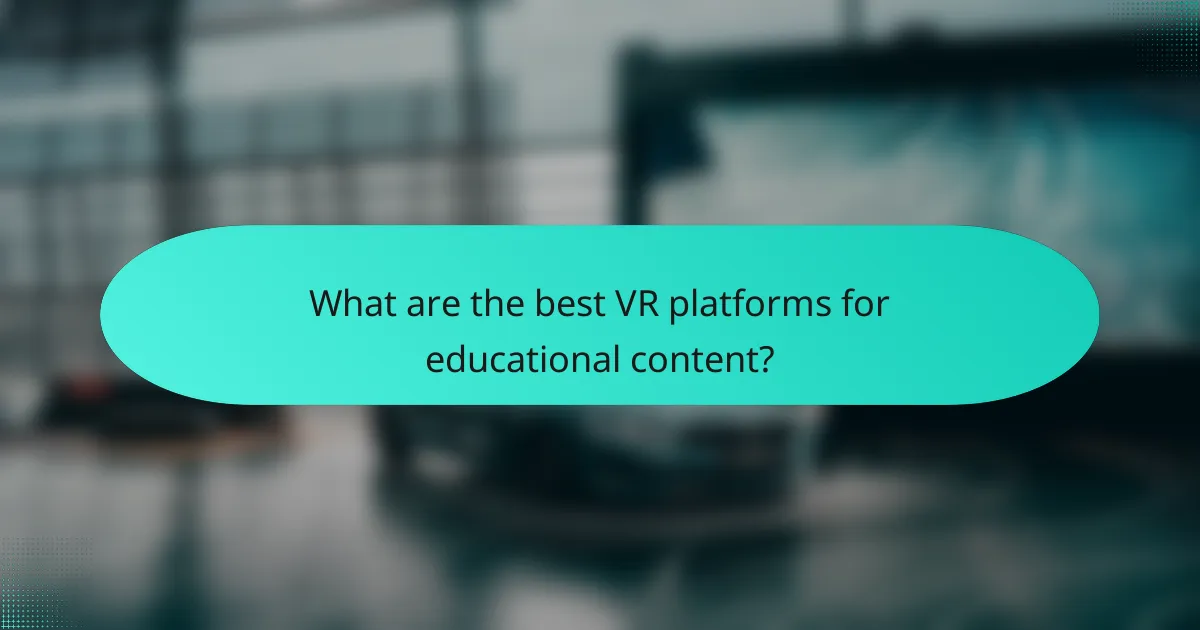
What are the best VR platforms for educational content?
The best VR platforms for educational content include Oculus, Google Expeditions, and ClassVR. These platforms offer immersive experiences that enhance learning through interactive simulations and virtual field trips.
Top VR platforms for educators
Oculus, Google Expeditions, and ClassVR are among the leading platforms that educators can utilize for immersive learning experiences. Oculus provides a wide range of educational applications, while Google Expeditions allows teachers to take students on virtual field trips. ClassVR focuses on providing a classroom-friendly solution with a library of educational content.
When selecting a platform, consider factors such as ease of use, content availability, and compatibility with existing classroom technology. Each platform has unique strengths that cater to different educational needs.
Features of Oculus for Education
Oculus for Education offers a variety of features designed to enhance the learning experience. It includes access to a diverse library of educational apps that cover subjects like science, history, and art. The platform supports multi-user experiences, allowing students to collaborate in virtual environments.
Additionally, Oculus provides tools for teachers to create custom content and experiences tailored to their curriculum. This flexibility enables educators to engage students in ways that traditional methods may not achieve.
Comparison of Google Expeditions and ClassVR
Google Expeditions and ClassVR both offer unique advantages for educators. Google Expeditions allows teachers to lead virtual field trips and explore 360-degree environments, making it ideal for experiential learning. In contrast, ClassVR provides a more structured approach with pre-loaded content and easy-to-use management tools.
When comparing the two, consider the level of interactivity desired. Google Expeditions excels in exploration and discovery, while ClassVR is better suited for guided lessons and assessments. Both platforms can significantly enhance student engagement and understanding of complex topics.
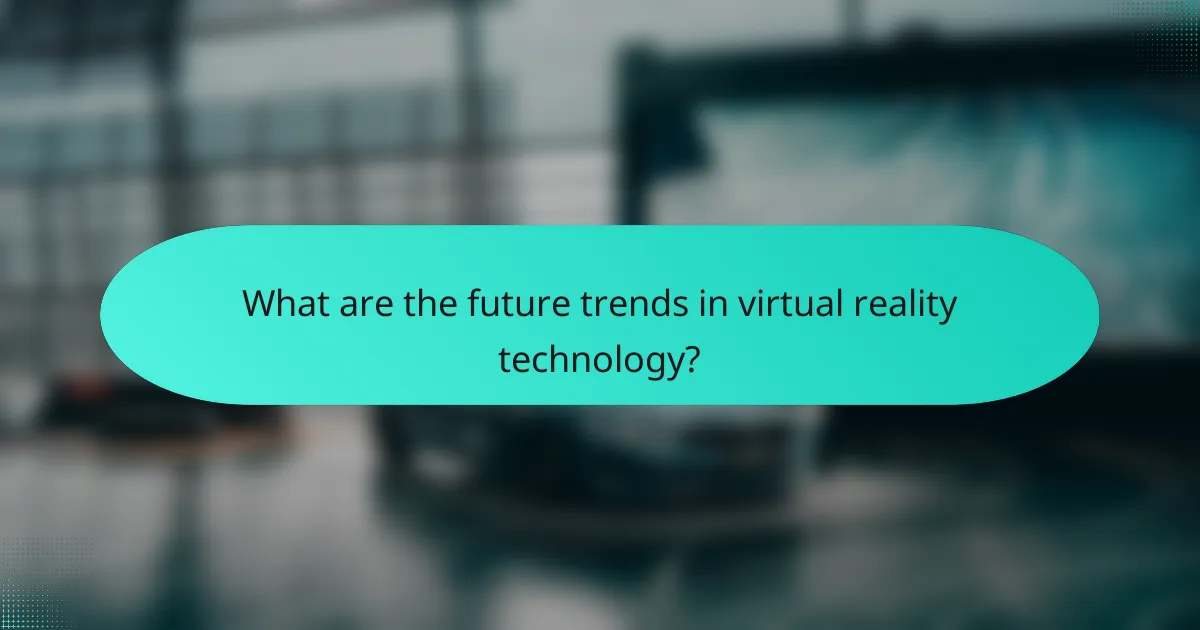
What are the future trends in virtual reality technology?
The future of virtual reality (VR) technology is marked by rapid advancements in hardware, software, and integration with artificial intelligence. These trends aim to enhance user immersion, accessibility, and educational applications, making VR experiences more engaging and effective.
Emerging VR technologies in 2024
In 2024, several emerging VR technologies are set to revolutionize the landscape. Notable advancements include improved haptic feedback systems that provide realistic sensations, eye-tracking capabilities for more intuitive interactions, and wireless solutions that enhance mobility without sacrificing performance.
Additionally, the integration of mixed reality (MR) features is expected to blur the lines between physical and virtual environments, allowing users to interact seamlessly with both. This convergence will create more versatile applications in gaming, training, and remote collaboration.
Predicted advancements in VR hardware
Future VR hardware is anticipated to become lighter, more powerful, and more affordable. Expect to see headsets equipped with higher resolution displays, offering clearer visuals and wider fields of view, which will significantly enhance the immersive experience.
Battery life is also likely to improve, with many devices aiming for several hours of continuous use. Furthermore, advancements in processing power will enable more complex simulations and environments, making VR applications more realistic and engaging.
Potential impacts of AI on VR experiences
Artificial intelligence is poised to transform VR experiences by personalizing content and interactions. AI algorithms can analyze user behavior to tailor experiences, making them more relevant and engaging based on individual preferences.
Moreover, AI-driven virtual characters and environments can respond dynamically to user actions, creating a more interactive and lifelike experience. This integration will enhance educational applications, allowing for adaptive learning environments that cater to various learning styles and paces.
